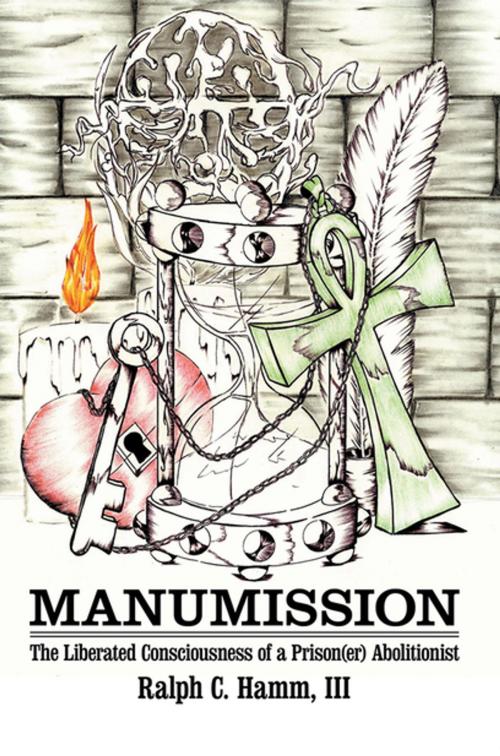Manumission
The Liberated Consciousness of a Prison(Er) Abolitionist
Fiction & Literature, Historical| Author: | Ralph C. Hamm III | ISBN: | 9781469168111 |
| Publisher: | Xlibris US | Publication: | March 29, 2012 |
| Imprint: | Xlibris US | Language: | English |
| Author: | Ralph C. Hamm III |
| ISBN: | 9781469168111 |
| Publisher: | Xlibris US |
| Publication: | March 29, 2012 |
| Imprint: | Xlibris US |
| Language: | English |
Ralph gives two suggestions for the four pages required for the Xlibris website. The first one is from Lesson 2, Section C in Manumission. The second one is from the synopsis for the book, which I believe is the Introduction. For the time being Ralph is choosing the Synopsis (Introduction) for the Xlibris website. Here they are:
1 From LESSON 2, SECTION C
To B.A.N.T.U., and thus to the N.P.R.A., the single conscious force had to arise from partaking in, and understanding, the common ground upon which all of the ethnic groups in the prison stood. The creative collective had to be rooted within our common history. Be it benign or volatile, the truth had to be shared.
Connectioncommunication...consciousness.
It may have been true that the Irish were the single-most obstacle in the way of peace and unity in the prison, as they were during the cause of the abolition of slavery in the 1800s in this country and state, but it was the purpose of the collective we to reveal to them who was pulling their historical strings... the true anti-abolitionists (i.e., the institution of education, of justice, of government, and the media).
We had to pull ourselves away from the inhuman voices of our ancestors, so that we could have a new and constructive dialogue. This dialogue could not be about retribution, revenge, or reparations, because none of us were responsible. This effort had to be one of conscious reconciliation, and recognizing that whether we liked it or not our futures were tied together. We were reclaiming our lives from those who claimed to possess us ...exploiting us by perpetuating our ancestral pasts against our todays and tomorrows.
I spent a lot of time during the course of my day speaking with (educating) N.P.R.A. block representatives. I questioned them on the perception of the racial barometer (tension) in their respective cellblocks: Were the prisoners talking to one another more, as opposed to alienating and isolating themselves based upon their ethnicity? How often did the reps notice prisoners reading, and/or discussing our political situation -could they give a number, or gauge a percentage? What was the reps opinion on the impact of the race-relations seminars? Were there any prisoners whom they thought Larry and I should speak with on the matter of race and the importance of N.P.R.A. unity?
I also made it a point to frequent the prison visiting room, not simply to troubleshoot (as was every board members responsibility) but to answer any questions posed by visitors regarding the N.P.R.A. political struggle. I saw these impromptu appearances in the visiting room as an opportunity to subtly ask the visitors if they noticed any changes in the demeanor of the prisoner they had come to visit; especially in regard to his impressions on politics, knowledge of history, and concern about race relations in the prison. The N.P.R.A. garnered invaluable information about the awareness of our constituency (and what may need to be improved upon in the way our communication with the prisoner body) utilizing the aforementioned approach -making our jobs as negotiators and instructors much easier; as well as affording us the first impression ability to spread the abolitionist agenda and ideology to the outside community (bypassing garbled media accounts of the struggle).
Being a hands-on person, I always liked to follow the adage: if you want something done right, then do it yourself. In this manner, I knew that the job was accomplished to the best of ability, and the results were not being interpreted and relayed to me through a third or fourth party -having lost much in the translation, due to modification of the message and personal impression, in the retelling. One of the tactics that I u
Ralph gives two suggestions for the four pages required for the Xlibris website. The first one is from Lesson 2, Section C in Manumission. The second one is from the synopsis for the book, which I believe is the Introduction. For the time being Ralph is choosing the Synopsis (Introduction) for the Xlibris website. Here they are:
1 From LESSON 2, SECTION C
To B.A.N.T.U., and thus to the N.P.R.A., the single conscious force had to arise from partaking in, and understanding, the common ground upon which all of the ethnic groups in the prison stood. The creative collective had to be rooted within our common history. Be it benign or volatile, the truth had to be shared.
Connectioncommunication...consciousness.
It may have been true that the Irish were the single-most obstacle in the way of peace and unity in the prison, as they were during the cause of the abolition of slavery in the 1800s in this country and state, but it was the purpose of the collective we to reveal to them who was pulling their historical strings... the true anti-abolitionists (i.e., the institution of education, of justice, of government, and the media).
We had to pull ourselves away from the inhuman voices of our ancestors, so that we could have a new and constructive dialogue. This dialogue could not be about retribution, revenge, or reparations, because none of us were responsible. This effort had to be one of conscious reconciliation, and recognizing that whether we liked it or not our futures were tied together. We were reclaiming our lives from those who claimed to possess us ...exploiting us by perpetuating our ancestral pasts against our todays and tomorrows.
I spent a lot of time during the course of my day speaking with (educating) N.P.R.A. block representatives. I questioned them on the perception of the racial barometer (tension) in their respective cellblocks: Were the prisoners talking to one another more, as opposed to alienating and isolating themselves based upon their ethnicity? How often did the reps notice prisoners reading, and/or discussing our political situation -could they give a number, or gauge a percentage? What was the reps opinion on the impact of the race-relations seminars? Were there any prisoners whom they thought Larry and I should speak with on the matter of race and the importance of N.P.R.A. unity?
I also made it a point to frequent the prison visiting room, not simply to troubleshoot (as was every board members responsibility) but to answer any questions posed by visitors regarding the N.P.R.A. political struggle. I saw these impromptu appearances in the visiting room as an opportunity to subtly ask the visitors if they noticed any changes in the demeanor of the prisoner they had come to visit; especially in regard to his impressions on politics, knowledge of history, and concern about race relations in the prison. The N.P.R.A. garnered invaluable information about the awareness of our constituency (and what may need to be improved upon in the way our communication with the prisoner body) utilizing the aforementioned approach -making our jobs as negotiators and instructors much easier; as well as affording us the first impression ability to spread the abolitionist agenda and ideology to the outside community (bypassing garbled media accounts of the struggle).
Being a hands-on person, I always liked to follow the adage: if you want something done right, then do it yourself. In this manner, I knew that the job was accomplished to the best of ability, and the results were not being interpreted and relayed to me through a third or fourth party -having lost much in the translation, due to modification of the message and personal impression, in the retelling. One of the tactics that I u















